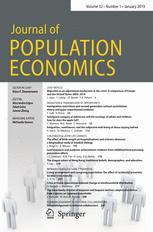The article concludes that the debate on rising health care expenditures should not be predominantly based on the growth effects of health care.
Read more in:
Annarita Baldanzi, Klaus Prettner & Paul Tscheuschner
Longevity-induced vertical innovation and the tradeoff between life and growth
Journal of Population Economics, Vol. 32 (2019), Issue 4 (October), pp. 1293-1313 .
GLO Fellow Klaus Prettner
Journal Website, complete issue 4.
Author Abstract: We analyze the economic growth effects of rising longevity in a framework of endogenous growth driven by quality-improving innovations. A rise in longevity increases savings and thereby places downward pressure on the market interest rate. Since the monopoly profits generated by a successful innovation are discounted by the endogenous market interest rate, this raises the net present value of innovations, which, in turn, fosters R&D investments. The associated increase in the employment of scientists leads to faster technological progress and a higher long-run economic growth rate. From a welfare perspective, the direct effect of an increase in life expectancy tends to be larger than the indirect effect of the induced higher consumption due to faster economic growth. Consequently, the debate on rising health care expenditures should not be predominantly based on the growth effects of health care.
Read also the Lead Article of issue 4 (2019):
Gautam Hazarika, Chandan Kumar & Sudipta Sarangi:
“Ancestral ecological endowments and missing women“
Journal of Population Economics, Vol. 32 (2019), Issue 4 (October), pp. 1101-1123
Journal Website, complete issue 4. Paper PDF – OPEN ACCESS.
GLO Fellows Gautam Hazarika, Chandan Kumar Jha & Sudipta Sarangi

Ends;

